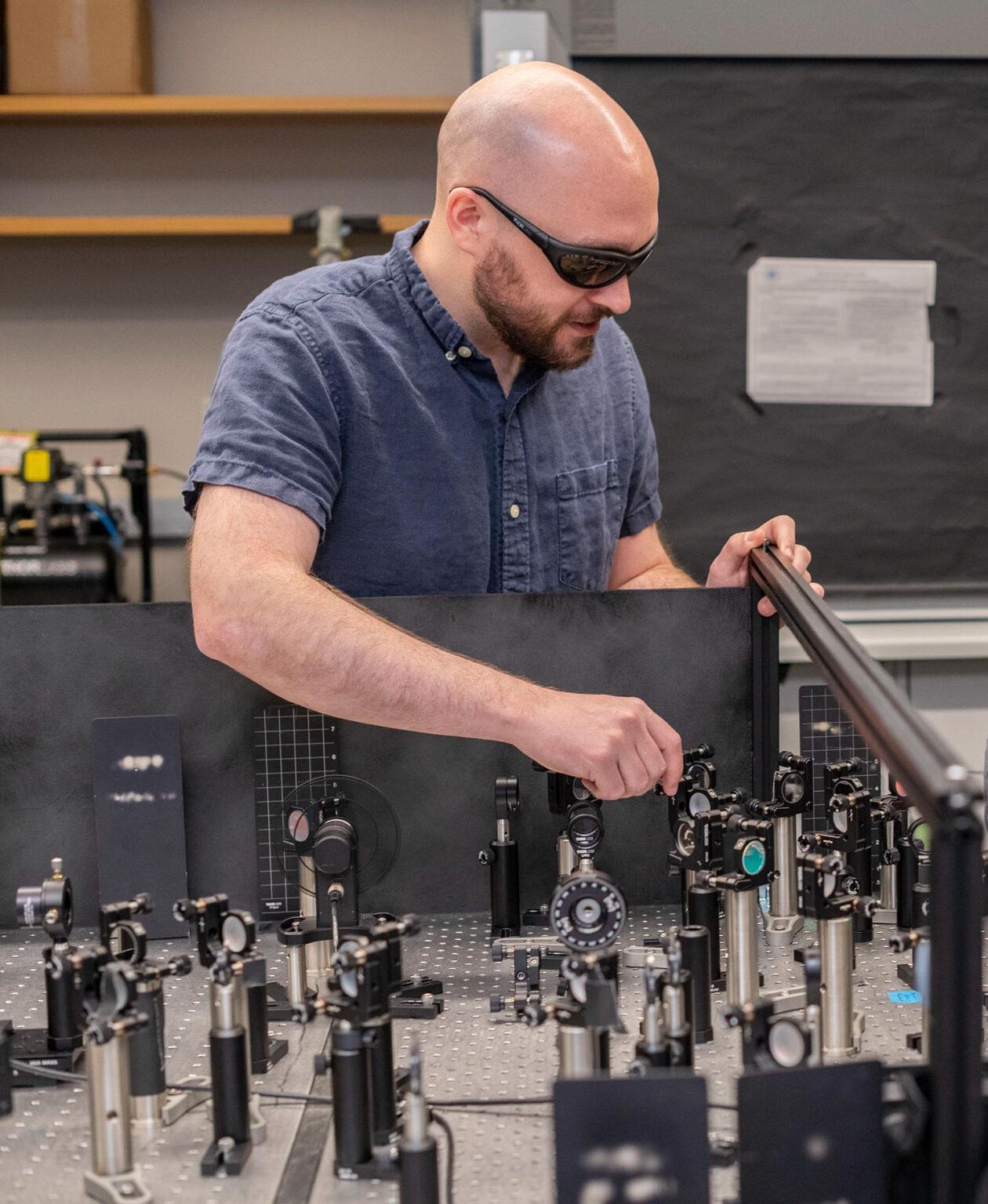A scientist from the University of Rhode Island will investigate a surprise chemical reaction that could be beneficial in releasing hydrogen for fuel cells thanks to an Early Career Award from the U.S. Department of Energy.
 Dugan Hayes, URI assistant professor of chemistry, in his lab at the Beaupre Center for Forensic and Chemical Sciences. Image Credit: Mike Salerno, University of Rhode Island
Dugan Hayes, URI assistant professor of chemistry, in his lab at the Beaupre Center for Forensic and Chemical Sciences. Image Credit: Mike Salerno, University of Rhode Island
Dugan Hayes, a chemistry assistant professor, is one of just 83 scientists countrywide selected for this year’s round of Early Career Award, which grants roughly $150,000 in research support per year for five years.
Hayes’ research group focuses on photochemistry, which is the study of chemical reactions that occur in response to light. Photosynthesis, the process by which plants transform light into the chemical energy they require to thrive, is by far the most well-known instance of photochemistry.
Photochemical reactions, on the other hand, are crucial in the biomedical sector, water purification, renewable energy, and other fields.
Hayes and his colleagues are working to figure out the specifics of how these reactions occur.
When a molecule absorbs light, there is a huge number of processes that can happen. There are physical processes in which bonds contract or elongate, and chemical processes where bonds are broken or new bonds are formed. Our goal is to figure out which processes happen in a given reaction, and the succession in which those steps occur.
Dugan Hayes, Assistant Professor, Department of Chemistry, University of Rhode Island
Hayes does this by employing transient absorption spectroscopy, a method that involves firing a sequence of laser pulses at photoreactive molecules.
The photochemical reaction is sparked by the first pulse, and following pulses probe the reaction stages as they occur. The key to the technology is the incredible speed with which the laser pulses occur, on the order of a few quadrillionths of a second.
Hayes added, “These reactions happen really fast. If you want to see what is happening, you need a camera shutter that is at least that fast, and that is what these laser pulses can do.”
Hayes believes that by better understanding each phase of the process, it might be feasible to optimize it to create more desirable reaction products more effectively. Hayes is particularly interested in the optimization of processes that occur during solar energy harvesting and other clean energy applications.
Hayes will utilize the approach to investigate a surprise chemical reaction that he and Carson Hasselbrink, a Ph.D. student in the Department of Chemistry at URI who will graduate in the fall, discovered by chance.
Hayes and Hasselbrink were researching a process that employs light to create significant aromatic compounds, which has been published in the scientific literature. Hayes and Hasselbrink wanted to learn more about how the reaction works, but they had to make a few changes to make it work with their laser technology.
They discovered that when they used a light-absorbing dye molecule called anthracene in the modified procedure, it created reaction products that no one had recognized before. A further reaction happened, producing aldehydes — a process that requires the emission of hydrogen gas — in addition to the predicted results.
“Basically, we showed that when you shine light on this molecule, which is readily available from any chemical supplier, it releases hydrogen gas—something that no one had noticed before. That is pretty exciting from the standpoint of hydrogen fuel cells. It means that this molecule can store hydrogen in solid form at room temperature and atmospheric pressure and then release it for use in fuel cells just by shining light on it”, stated Hayes.
One of the major difficulties that must be addressed if hydrogen fuel cells are to be used to power vehicles and trucks is the storage of hydrogen. Since hydrogen gas has a low energy density, large tanks are required to store enough to power a fuel cell.
While storing hydrogen as a liquid takes up less room, it must be stored at temperatures close to absolute zero. However, Hayes believes that storing hydrogen as a solid and releasing it on demand through a photochemical process might be a boon for hydrogen energy.
Anthracene is also derived from coal waste products. Putting those contaminants to good use gives this reaction additional clean energy appeal.
Hayes and his students will use ultrafast laser technology to analyze this interaction over the next five years. The goal is to gain a better understanding of how it functions and, ideally, identify methods to improve it.
Hayes is optimistic that this reaction may lead to a breakthrough in sustainable energy in the future, but for now, he wants to learn more about the chemistry underlying it.
Hayes concluded, “Most photochemical reactions are pretty well-known, but this is something completely new. As a chemist, that is a really exciting thing.”